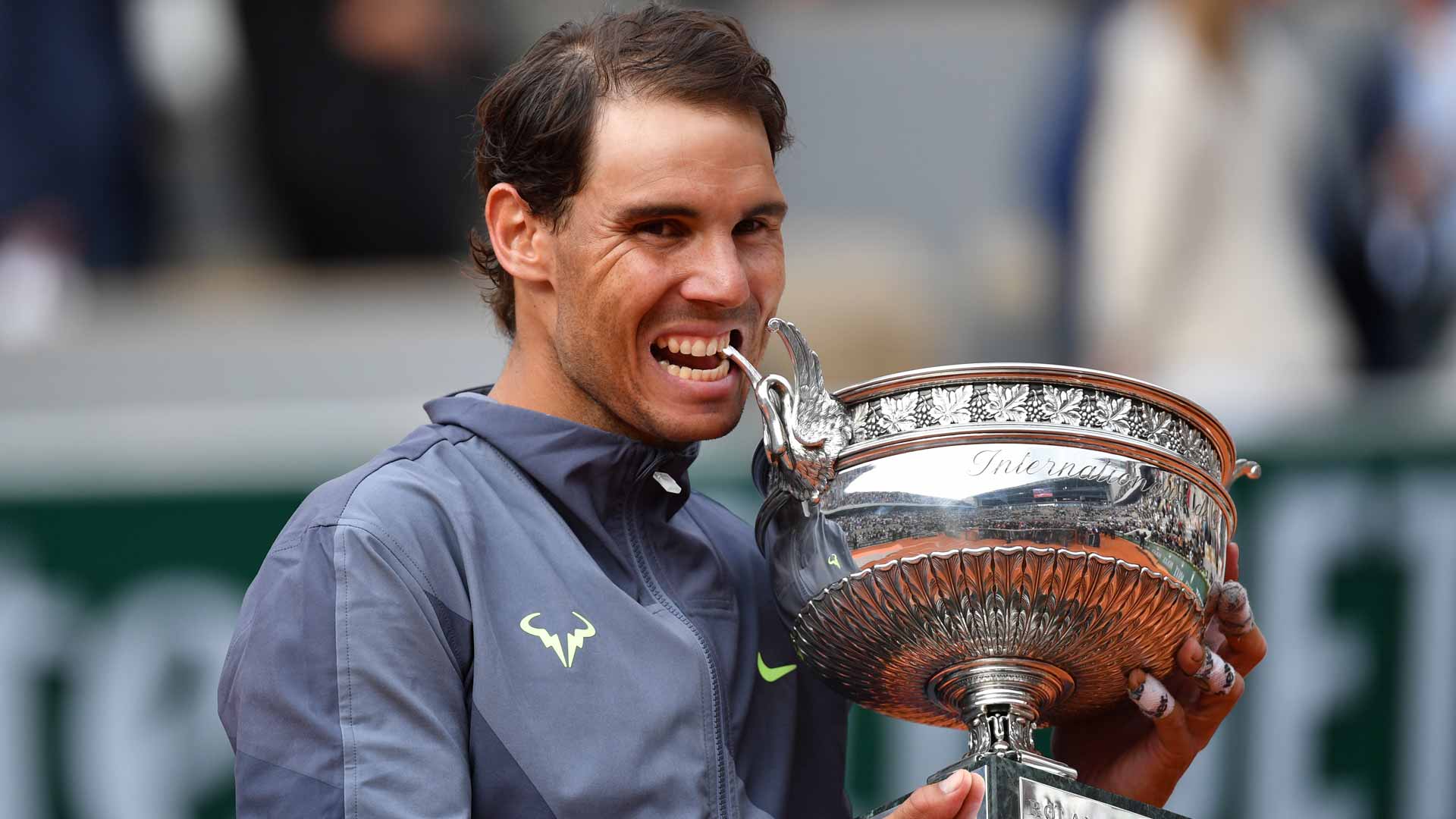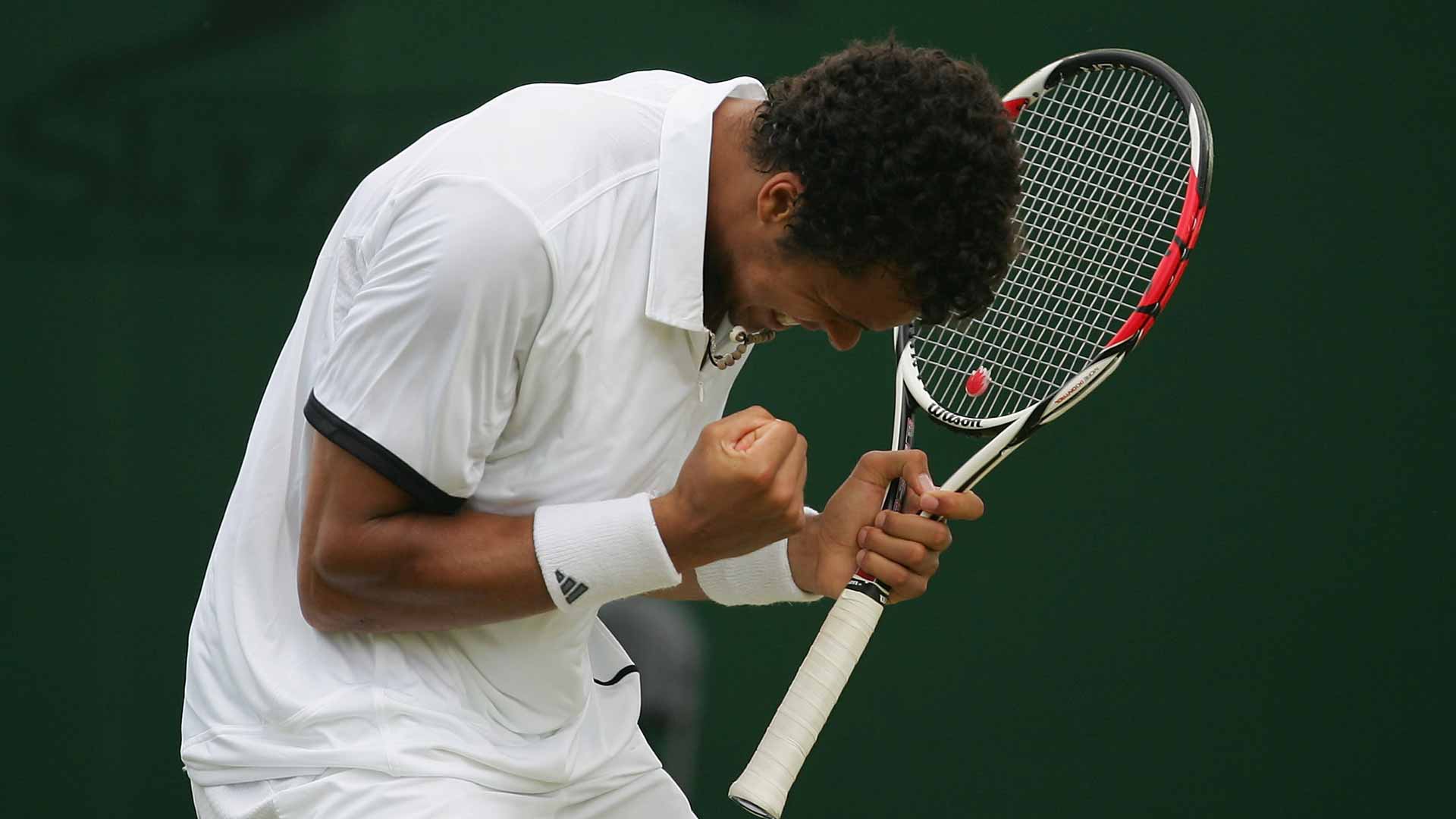Winning a Grand Slam is an incredible feat, but winning 12 at one event is otherworldly.
Rafael Nadal has lifted the Coupes des Mousquetaires at Roland Garros on 12 occasions, triumphing at the clay-court major more frequently than any other player in history. ATPTour.com looks back at his dozen triumphs in Paris, from his maiden crown as a teenager in 2005 to his latest as a 33-year-old man in 2019.
2005
Despite having never played at Roland Garros before, Nadal arrived as the hot favourite after picking up ATP Masters 1000 titles in Monte-Carlo and Rome, in addition to triumphing on home soil in Barcelona. After defeating Roger Federer in a four-set semi-final on his 19th birthday, he picked up the first Grand Slam title of his career by beating Mariano Puerta 6-7(6), 6-3, 6-1, 7-5.
“Everything happened very quickly,” Nadal reflected years later. “I went from being No. 50 in the [FedEx ATP Rankings] to fighting to win Roland Garros. I think in my head I assimilated that well, calmly. I think I had been adequately educated to be prepared in case something like that happened. I accepted everything as if it were normal and I think that that was one of the keys to being able to continue with the same intensity of work, passion and motivation.”

2006
Nadal’s route to defending his title was not without difficulty. In the third round, he needed four hours and 53 minutes to survive home favourite Paul-Henri Mathieu 5-7, 6-4, 6-4, 6-4, a match which remains the longest he’s ever played at this event. But the Spaniard triumphed in Paris once again by defeating Federer 1-6, 6-1, 6-4, 7-6(4).
He also set a new record that year. By beating Robin Soderling in the first round, Nadal won 54 straight matches on clay and surpassed Guillermo Vilas’ record for most consecutive victories on the surface.
“He always seemed to me a spectacular tennis player. He is able to deal with competitiveness with maturity,” said three-time Roland Garros champion Gustavo Kuerten to ATPTour.com in 2012. “That’s how Nadal won the tournament.”
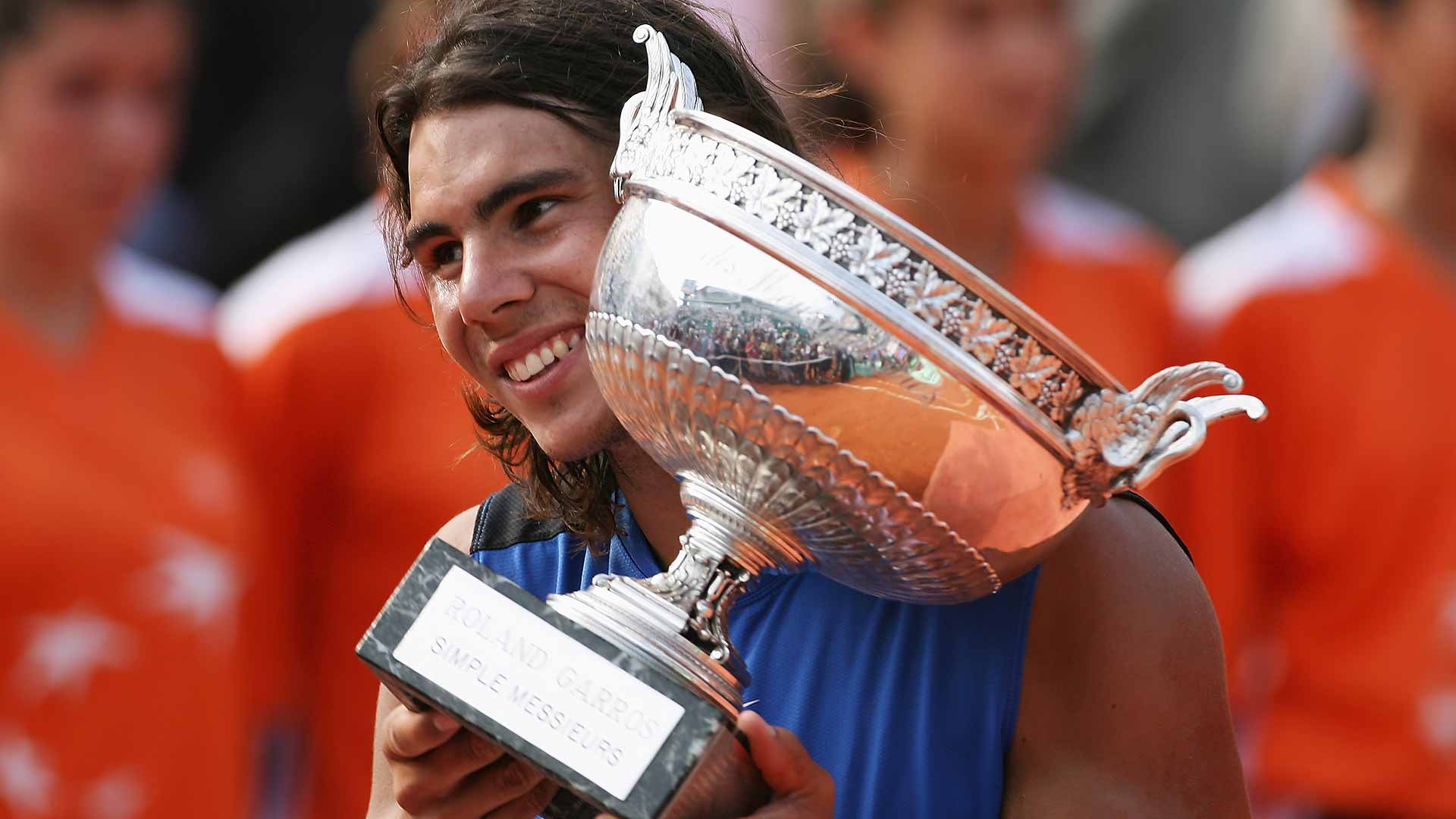
2007
For his Roland Garros hat trick, Nadal once again outlasted Federer in the final and prevailed 6-3, 4-6, 6-3, 6-4. At age 21, he became the youngest player to earn three titles in Paris. The Spaniard didn’t drop a set en route to the final, scoring notable wins over Juan Martin del Potro, Lleyton Hewitt, Carlos Moya and Novak Djokovic along the way.
“In 2007, I started to feel that Nadal was a better player than Federer on clay,” said Moya, now Nadal’s current coach, to ATPTour.com in 2012. “That was the first year I felt that Rafa was controlling the match, controlling the point, and the way he was losing that set against Federer was because he was not playing at his best. When he was playing at his best, he was finding his way to beat Federer.”

2008
Nadal equalled Bjorn Borg’s four consecutive titles (1978-1981) at Roland Garros with a flawless display of tennis. He didn’t drop a set during the fortnight, easing past Djokovic 6-4, 6-2, 7-6(3) in the semi-finals before routing Federer 6-1, 6-3, 6-0 in the championship match.
“The most amazing thing obviously is the guy comes in, three-time champion, and that was probably from start to finish his most dominant performance,” said Brad Gilbert to ATPTour.com in 2012. “It just kind of had that feeling they’re just watching it from afar, that nobody had a shot the way he was playing at the moment.”

2010
Having suffered his first defeat to at Roland Garros the previous year at the hands of Soderling, Nadal gained revenge by winning back the trophy with a dominant 6-4, 6-2, 6-4 win against him in the final. Once again, the Spaniard won the Coupes des Mousquetaires without dropping a set during the tournament.
“I think that win, that final against Soderling, sort of got his career back on track,” said three-time Roland Garros champion Mats Wilander to ATPTour.com in 2012. “It was the match that made him believe that he’s not done and it transformed his game.”

2011
By winning his sixth title in Paris, Nadal tied Borg’s record for most singles titles at this event. His path was less straightforward than in previous years, though. He was down two-sets-to-one in his opening round against John Isner before fighting back to win in five sets, then outlasted an inspired Federer in the final to score a 7-5, 7-6(3), 5-7, 6-1 victory.
“Nadal ensures his opponents have to deal with a variety of spins, and his margin for error in these long rallies is incomprehensible,” explained 1999 Roland Garros champion Andre Agassi to ATPTour.com in 2012. “He hits close to the lines to move his opponent around the court. He strikes his forehand so he puts it above his opponent’s shoulder and Nadal is consistently great in defence.
“That is why Nadal is so tricky to beat in five sets, especially at Roland Garros. He is like a boxer who constantly jabs. It totally wears an opponent down.”
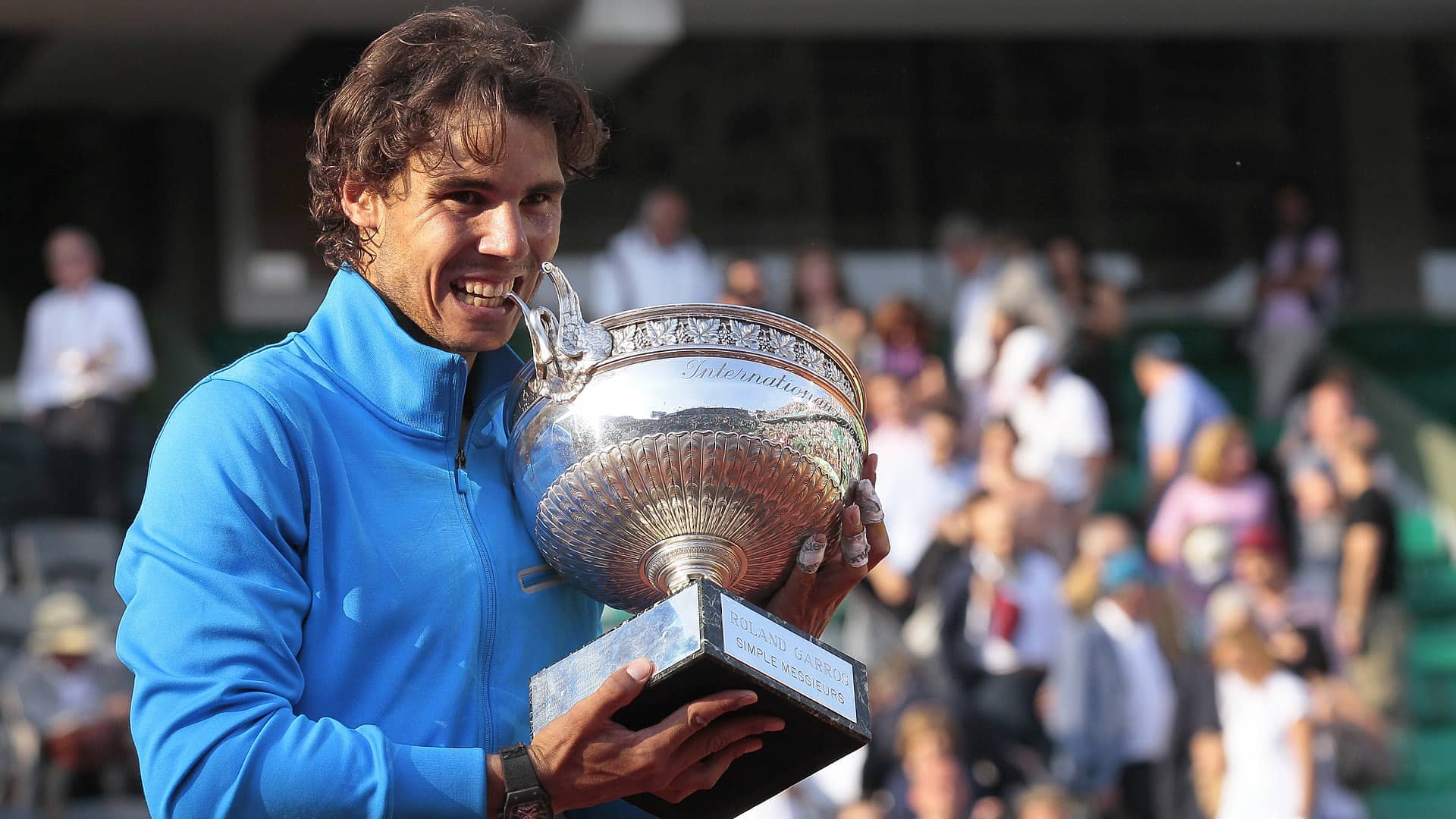
2012
In a final that ended on Monday due to rain, Nadal beat Djokovic 6-4, 6-3, 2-6, 7-5 and broke Borg’s record with his seventh Roland Garros title. He raised his level with each match, cruising past good friend Juan Monaco in the fourth round before easing past fellow countrymen Nicolas Almagro and David Ferrer in the quarter-finals and semi-finals, respectively.
“For me, it’s really an honour,” the Mallorcan said after his victory. “Borg is one of the greatest of history, so for me, the comparison with the great Bjorn is fantastic.”
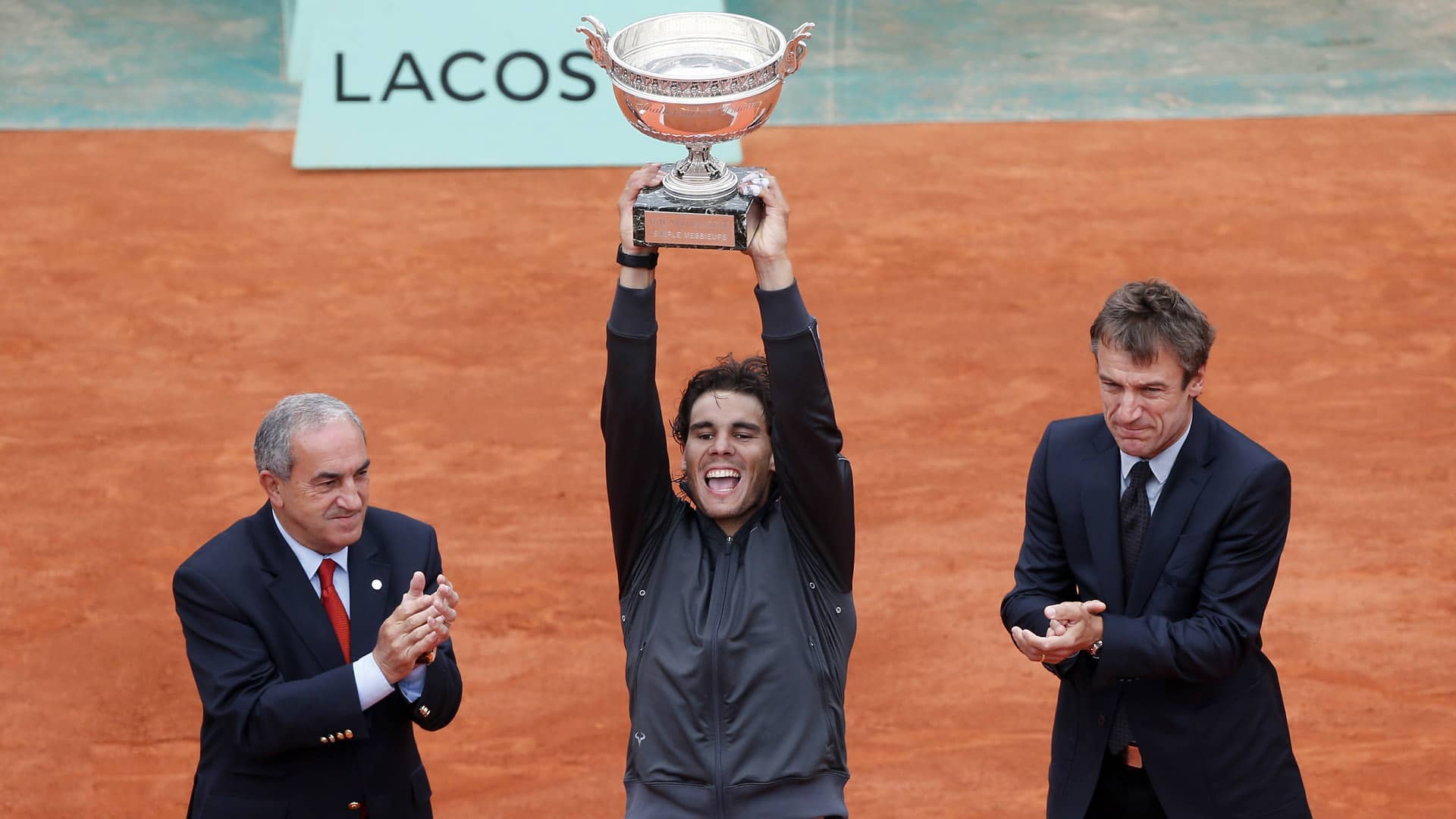
2013
In 2013, Nadal became the first player to win the same Grand Slam eight times. He was forced to rally from a set down in his first two rounds against Daniel Brands and Martin Klizan, then dug deep against Djokovic in the semi-finals to prevail 9-7 in the fifth set. Nadal saved his best for last to blitz Ferrer 6-3, 6-2, 6-3 in the final.
“The feeling on court was great. The match[es] against David are always difficult,” Nadal said. “I think the score is much easier than what the match was today. I think for moments I played great. I think a few moments in the match, I played at very, very high level.
“Eight times here is a lot. I never thought about that. But I will keep practising with the same passion and intensity to bring my tennis to the highest level possible.”

2014
Nadal was pushed early on in his quarter-final against Ferrer before finding a new gear and cruising to 4-6, 6-4, 6-0, 6-1 win. He then equalled Pete Sampras’ mark of 14 Grand Slam titles when he sealed his ninth Roland Garros crown, putting him in a tie for second place on the all-time list, by once again defeating Djokovic 3-6, 7-5, 6-2, 6-4 in a thrilling final
“Federer has 17 and I have [won] 14 Grand Slams,” said Nadal. “[Breaking the record], it’s not a source of motivation for me. I’ll follow my own path. Then when my career is over, we’ll count. I don’t really care that much about the records. I’ll still play with a lot of intensity. I’ll still be motivated.
“To me, winning is the result, the equivalent of lots of effort. Therefore, I feel more serene and personally I’m very satisfied.”

2017
Nadal was unable to lift the Coupes des Mousquetaires in his previous two attempts, withdrawing before the third round in 2016 due to a wrist injury and falling to Djokovic in the 2015 quarter-finals. But it only made his 2017 triumph that much sweeter. He stormed to the title without dropping a set and dominated Stan Wawrinka 6-2, 6-3, 6-1 in the championship match to earn his 10th Roland Garros crown, a feat referred to as “La Decima”.
“It’s been magical, all the things that have happened in this tournament for me. I’m so very happy for everything,” Nadal said. “Today was a very important day for me. There have been some tough moments [and] injuries, so it’s great to have big success like this again.”
2018
Nadal’s streak of 37 consecutive sets won ended in the quarter-finals against Diego Schwartzman, but he held off the Argentine to advance 4-6, 6-3, 6-2, 6-2. In the final, Nadal defeated Dominic Thiem 6-4, 6-3, 6-2 to defend his crown and hold the Coupes des Mousquetaires for an 11th time.
“Coming back and to have the chance to win in Monte-Carlo, Barcelona, Rome, and now especially here, it’s very emotional for me,” Nadal said. “It was a very special moment and well received, that minute or two minutes of the crowd supporting me. That feeling in that moment was difficult to describe it. Very emotional for me.

2019
Nadal and Federer had not met at Roland Garros since 2011, but they reunited on Court Philippe Chatrier in 2019 as the Spaniard scored a convincing 6-3, 6-4, 6-2 victory in the semi-finals. Nadal and Thiem faced off again in the final and the Spaniard triumphed once again with a breathtaking 6-3, 5-7, 6-1, 6-1 performance. Nadal’s 12th title in Paris made him the first player in history to win 12 titles from an individual Grand Slam tournament, surpassing Margaret Court’s 11 titles at the Australian Open.
“What I have to do today is not think about if it’s incredible, because it’s a real thing for me. Even if it’s something I never dreamed about five, six, eight years ago, it’s happening today. And my goal is just try to keep going,” Nadal said. “It’s not about having excess ambition, but it’s about just trying to keep enjoying the things that I am doing.”
